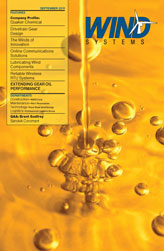September 2011
ARTICLES
Lack of proper planning during crane walks results in schedule issues and unexpected costs
Lack of proper planning or poor scope definition during crane walks predictably results in schedule issues and unexpected costs. Here’s how to prepare your path.
Tracked cranes perform nearly all of the new wind farm construction in North America. One challenge is moving the nearly 1,000,000-lb machines between turbines without performing either a full or partial breakdown, which can take days to complete. Lack of proper planning or poor scope definition during the crane walks predictably results in schedule issues […]
A predictive program will include an assessment of the failure mode for each event
Where an OEM scheduled maintenance plan takes only component life into account, a predictive program will include an assessment of the failure mode for each event.
Surprisingly, maintenance practices in the wind industry are still guided mostly by time-based activities. Meant to be a proactive approach to servicing multimillion-dollar equipment, the scheduled maintenance activities are performed at routine intervals, combining the most conservative engineering estimates with a bit of luck that we catch failure events before they occur. Throw in 50 […]
Turbine technology is rapidly evolving to meet the stringent demands of grid stability, reliability
Turbine technology is rapidly evolving to meet the stringent demands of grid stability, reliability, and economic extraction of wind energy from lower average wind speed sites.
The 2010 annual Wind Technologies Market Report by Ryan Wiser and Mark Bolinger, both of Lawrence Berkeley National Laboratory, was released in June 2011. It can be downloaded at www1.eere.energy.gov/windandhydro/pdfs/51783.pdf. This report has noted a decline in capacity factors for U.S. projects over the last few years (fig. 34). This is not because there has […]
Barge is a third viable form of transport for wind components
Barge is a third viable form of transport for wind components, especially in strategically located wind farms near water access or for the import or export of components.
Traditionally, the most common method of transporting large wind components has been via specialized truck transportation carriers. In recent years rail transport has been effectively utilized by large volume manufacturers such as GE, Vestas, and Siemens. In special cases, however, there is a third option for moving components that takes advantage of the extensive inland […]
NEWS
New Wind Energy Projects to Benefit Ontario Communities
The Canadian Wind Energy Association (CanWEA) welcomes the announcement by the Ontario Power Authority (OPA) and Ontario Government to offer contracts to 19 new wind energy projects that would add 1,018 MW of new wind energy capacity to the Ontario grid. Located in the Bruce region and in the area west of London, these new […]
August 29, 2011
Registration Open for Renewable Energy Markets 2011 Conference
Register now and take advantage of the early-bird rate at this year’s exciting Renewable Energy Markets 2011 conference in San Francisco, CA from November 15–18, 2011. Topics include: Market Growth Opportunities: Electric Vehicles, Green Buildings, and moreGreen Marketing: Customer Trends, Social Media, and Going MainstreamUtilities: Maintaining and Growing Utility Green Power ProgramsPolicy Updates: Regulation, GHG […]
August 29, 2011



























